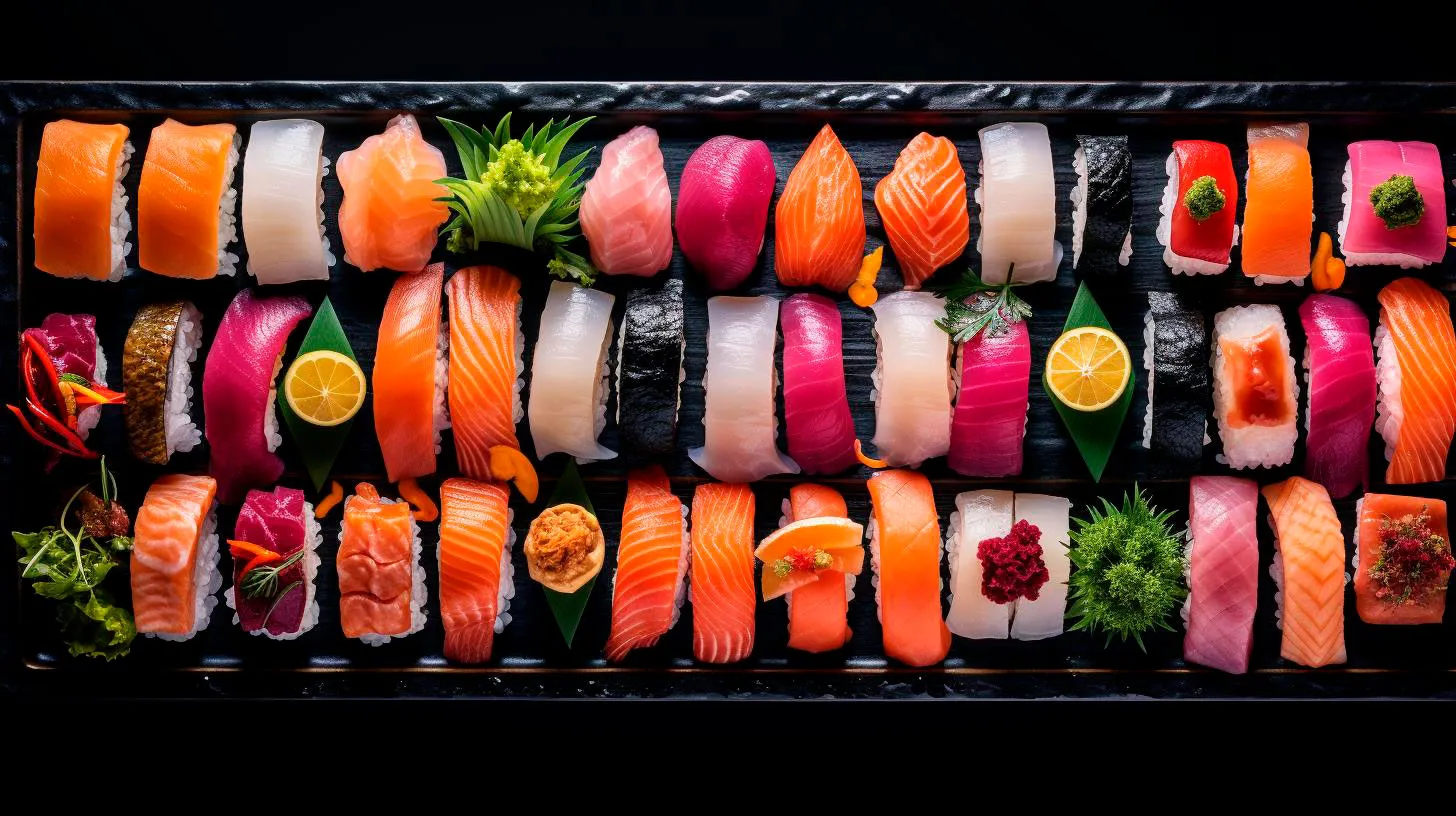Fresh Fish and Flavors: Unveiling the Art of Sushi Making
In this article, we will dive into the mesmerizing world of sushi making, exploring its rich history, key techniques, and the importance of using fresh ingredients. So, put on your apron, sharpen those knives, and let’s unravel the secrets to crafting exquisite sushi rolls!
The History of Sushi: A Journey Through Time
Before we embark on our sushi-making adventure, let’s take a step back and explore the fascinating history behind this culinary marvel. Dating back to the 2nd century A.D., sushi was initially developed as a preservation method in Southeast Asia. The combination of fermented rice and salted fish created a dish that could be stored for extended periods. As time passed, this preservation technique evolved, with the Japanese incorporating fresh fish and seafood to create the sushi we know and love today.
Over the years, sushi transformed from mere sustenance to a fine art form. In the 19th century, Yohei Hanaya, widely regarded as the father of modern sushi, introduced nigiri sushi – small mounds of vinegared rice topped with fresh fish. This innovation revolutionized the sushi landscape, paving the way for the diverse range of sushi we enjoy today.
The Art of Sushi Making: Mastering the Techniques
Sushi making is an intricate process that requires precision, patience, and a deep understanding of flavor combinations. Here are some essential techniques that sushi chefs employ to ensure each bite is a harmonious balance of taste and texture:
1. Knife Skills:
- Mastering the art of sushi making begins with the proper handling of a sushi knife.
- A sharp and well-maintained knife is crucial for creating clean cuts and precise slices.
- With the right technique, chefs can highlight the freshness and delicate flavors of the fish.
2. Sushi Rice:
- The foundation of any sushi roll is the perfectly seasoned sushi rice.
- Japanese short-grain rice, combined with vinegar, sugar, and salt, creates the ideal balance of sweetness and tanginess.
- The rice should be carefully prepared to achieve the desired sticky consistency, allowing it to hold the ingredients together.
3. Nigiri Sushi:
- The pinnacle of sushi elegance, nigiri sushi, showcases the chef’s expert craftsmanship.
- A small ball of sushi rice is paired with various toppings, such as fresh fish or tamago (sweet omelet).
- The chef must skillfully mold the rice and delicately place the topping to create a visually appealing and flavorful bite.
4. Sushi Roll (Maki) Techniques:
- Maki, or sushi rolls, offer endless possibilities for flavor combinations.
- Whether making a traditional nori-wrapped roll or an inside-out roll, precision is key.
- The ingredients must be evenly spread and tightly rolled to achieve a beautiful presentation and ensure the roll doesn’t fall apart.
The Key to Exceptional Sushi: Fresh Fish and Ingredients
One cannot overstate the importance of using fresh, high-quality fish and ingredients when it comes to creating outstanding sushi. The freshness of the fish not only enhances the flavors but also ensures a safe and enjoyable dining experience. Here are the key reasons why fresh ingredients are imperative for sushi making:
1. Flavorful Experience:
Fresh fish brings unrivaled flavors to sushi, providing a delicate texture and a burst of umami. The natural sweetness and essence of the fish shine through, elevating each bite into a sensorial journey.
2. Food Safety:
Consuming raw fish carries inherent risks; therefore, it is vital to source fish known for its superior quality. Fresh fish is less prone to harmful bacteria and parasites, minimizing the potential health hazards associated with undercooked seafood.
3. Aesthetics and Presentation:
In sushi making, presentation is as important as taste. The vibrancy and visual appeal of fresh fish contribute to the aesthetic allure of each sushi roll, making it a feast for the eyes before it reaches the palate.
The Sushi Revolution: Fusion and Innovation
While traditional sushi holds a special place in our hearts, the world of sushi has experienced a delightful revolution. Contemporary sushi chefs are pushing boundaries, blending traditional techniques with modern flavors and ingredients. This fusion approach has given rise to innovative sushi creations, such as:
- Sushi Burritos: A marriage between sushi and burritos, these oversized rolls offer a satisfying, portable meal.
- Sushi Burgers: A delightful twist on a classic, sushi burgers replace buns with rice patties, encapsulating mouthwatering fillings.
- Sushi Pizza: Combining the best of Japanese and Italian cuisines, sushi pizza boasts a crispy rice crust topped with an assortment of sushi toppings.
Key Takeaways: Unleash Your Inner Sushi Chef
As we conclude our journey through the art of sushi making, here are a few key takeaways to inspire you:
- The history of sushi is a testament to the transformative power of culinary innovation.
- Mastering knife skills and sushi techniques is essential for crafting authentic and visually stunning sushi.
- Using fresh, high-quality ingredients is crucial for an exceptional sushi dining experience.
- Don’t be afraid to experiment and blend flavors to create your own unique sushi creations.
Embark on your sushi-making adventure, embracing the artistry and flavors that sushi brings to your palate. Whether you’re a novice or a seasoned chef, the art of sushi making is a lifelong journey that never ceases to amaze!
Beyond Sushi Rolls: Discovering the Diverse World of Japanese Cuisine
In this article, we will explore some of the lesser-known aspects of Japanese cuisine and showcase the unique culinary delights that Japan has to offer.
The Art of Ramen Noodles
Ramen, a traditional Japanese noodle soup dish, has gained international popularity in recent years. With its rich broth, chewy noodles, and an array of toppings, ramen has become a favorite comfort food for many. But did you know that there are several different types of ramen to explore?
- Shoyu Ramen: This is the most common type of ramen, made with a soy sauce-based broth. It is often topped with sliced pork, green onions, nori, and a soft-boiled egg.
- Miso Ramen: Miso paste is used to create the broth for this ramen variation, resulting in a slightly sweet and savory flavor. Toppings usually include bean sprouts, corn, and marinated pork.
- Tonkotsu Ramen: This ramen variety features a rich and creamy broth made from pork bones. It is typically topped with sliced pork belly, green onions, and a soft-boiled egg.
Each type of ramen offers a unique taste experience, and trying them all is a must for any food lover. So, step outside your comfort zone and savor the delightful flavors of the various ramen styles.
The Versatility of Tempura
Tempura is a popular Japanese dish that consists of battered and deep-fried seafood, vegetables, or even ice cream. This cooking technique was introduced to Japan by Portuguese traders in the 16th century and has since evolved into a beloved national dish. What sets tempura apart is its light and crispy texture, achieved by using a specific batter and precise frying techniques.
Here are some key points about tempura:
- Wide Range of Ingredients: Tempura can be made with various ingredients such as shrimp, squid, sweet potatoes, eggplant, and even green tea ice cream. This versatility allows for endless combinations and flavor profiles.
- Delicate Batter: Tempura batter is made by mixing flour, egg, and ice-cold water. The batter should be lumpy and should not be overmixed to maintain its light and crispy texture.
- Precise Frying: The temperature of the oil and the timing are crucial for achieving the perfect tempura. The ingredients are fried at a high temperature for a short period to ensure that they cook evenly and remain crispy.
Tempura is often served as an appetizer or as a side dish with a dipping sauce. Its unique flavor and texture make it a delightful addition to any Japanese meal.
Traditional Green Tea: Matcha
Green tea, particularly matcha, holds a special place in Japanese culture. Matcha is a finely ground powder made from specially grown and prepared green tea leaves. It has been used in traditional Japanese tea ceremonies for centuries.
Here are some of the characteristics of matcha:
- High in Antioxidants: Matcha is packed with antioxidants, which are beneficial for overall health and well-being.
- Boosts Concentration and Energy: Matcha contains caffeine and a unique amino acid called L-theanine. Together, they provide a calming yet focused energy boost.
- Versatile Ingredient: Apart from being consumed as a tea, matcha is also used as a flavoring agent in various desserts, such as matcha ice cream, cakes, and mochi.
With its vibrant green color and distinct flavor, matcha has become increasingly popular worldwide. Adding matcha to your daily routine can be a healthy and refreshing way to explore Japanese cuisine.
The Key Takeaways
Japanese cuisine offers far more than just sushi rolls. Exploring the diverse world of Japanese food can be a rewarding and exciting culinary adventure. Remember these key takeaways as you embark on your journey:
- There are various types of ramen to try, each with its own unique flavor profile and toppings.
- Tempura is a versatile dish that can be made with a wide range of ingredients, providing a crispy and delightful eating experience.
- Matcha, a finely ground green tea powder, offers a unique taste and numerous health benefits.
So, go beyond sushi rolls and delve into the enchanting world of Japanese cuisine. Discover new flavors, savor traditional dishes, and embrace the culinary delights that Japan has to offer.
The Power of Wasabi: Understanding Japan’s Fiery Green Condiment
In this article, we will explore the power of wasabi, its origins, benefits, and the various ways it can be used in culinary delights.
The Origins of Wasabi
Wasabi, scientifically known as Wasabia Japonica, is native to Japan and primarily cultivated in cool, mountainous regions. Traditionally, it was grown alongside streams, as the plants require constant water flow for development. The root of the wasabi plant is the part that is most commonly used for culinary purposes.
Historically, wasabi was used in Japan for medicinal purposes due to its antibacterial properties and potential to prevent food poisoning. It was also believed to have anti-inflammatory and pain-relieving benefits. Today, it is primarily valued for its unique flavor and ability to elevate the taste of various dishes.
The Benefits of Wasabi
Aside from its distinct taste, wasabi provides several health benefits that make it even more appealing. Here are some key advantages of incorporating wasabi into your diet:
- Antibacterial properties: Wasabi contains compounds known as isothiocyanates, which exhibit strong antimicrobial properties that help fight against harmful bacteria.
- Rich in antioxidants: Wasabi is packed with antioxidants that help in neutralizing harmful free radicals in the body, protecting against cell damage and reducing the risk of chronic diseases.
- Boosts digestion: The enzymes present in wasabi aid in the breakdown of fats, making it easier for the body to digest food and absorb nutrients efficiently.
- Anti-inflammatory effects: Studies show that the compounds found in wasabi have anti-inflammatory properties, which may help in reducing inflammation and associated pain.
- Supports respiratory health: The strong aroma and flavor of wasabi can help open up nasal passages and relieve congestion, making it beneficial for individuals with respiratory conditions.
Key Takeaways and Uses
Now that we understand the origins and benefits of wasabi, let’s explore the various ways this fiery condiment can be incorporated into culinary creations:
1. Sushi and Sashimi
Wasabi is most commonly known for being served with sushi and sashimi. It adds a spicy kick while complementing the flavors of raw fish and rice.
2. Wasabi Paste
Creating a wasabi paste is as simple as mixing the powdered form with water. This versatile paste can be used as a condiment or added to sauces, giving them an extra zing.
3. Wasabi Mayonnaise
Mixing wasabi paste with mayonnaise creates a creamy and tangy sauce that pairs perfectly with sandwiches, grilled meats, and vegetables.
4. Wasabi Peas
Coated in a crunchy layer of wasabi-flavored seasoning, these peas make for a delightful snack with a spicy twist.
5. Wasabi Infused Oil
Infusing oil with wasabi creates a flavorful base for stir-fried dishes or salad dressings. The heat of the wasabi adds a unique taste to the dish.
With its strong flavor and numerous health benefits, wasabi continues to captivate food enthusiasts worldwide. Whether you enjoy it with sushi, use it as a condiment, or experiment with creative recipes, wasabi adds a fiery punch to any dish. Incorporate this versatile ingredient into your culinary repertoire and experience the power of wasabi for yourself!
The Origins of Sushi: Exploring Japan’s Culinary Heritage
Sushi traces its roots back to ancient Japan, dating back to the 8th century. Originally, sushi was developed as a method to preserve fish. The salted and fermented fish was packed between layers of vinegared rice. Over time, this preservation technique evolved into something much more refined, incorporating diverse flavors and techniques.
As sushi expanded across Japan, various regional styles emerged. Let’s dive into some of these unique types:
Nigiri Sushi
Nigiri sushi is one of the most recognized forms of sushi globally. It consists of a small mound of vinegared rice topped with a slice of fresh fish or seafood. Some key points about nigiri sushi include:
- Freshness is paramount: Nigiri sushi showcases the delicate flavors of the fish, and therefore, only the freshest catch is used.
- Simplicity is key: The simplicity of nigiri sushi allows the taste and texture of the raw fish to shine through.
- Balance is crucial: Each piece of nigiri sushi aims to strike a perfect balance between the rice and the topping, creating a harmonious flavor profile.
Maki Sushi
Maki sushi, or sushi rolls, are perhaps the most well-known form of sushi outside of Japan. These rolls consist of vinegared rice and various fillings, wrapped in a sheet of seaweed called nori. Here are some highlights of maki sushi:
- Versatility in fillings: Maki sushi offers endless possibilities in terms of fillings, ranging from fresh seafood to vegetables and even unconventional ingredients like cream cheese or mango.
- Visual appeal: Maki sushi often showcases colorful and vibrant ingredients, making it an aesthetically pleasing dish.
- Accessibility: The bite-sized pieces of maki sushi make it easy to eat with chopsticks or even with your hands.
Sashimi
While not technically sushi, sashimi plays an integral role in Japan’s culinary heritage and is often served alongside sushi. Sashimi is thinly sliced raw fish or seafood, enjoyed on its own without rice. Key takeaways about sashimi include:
- Pure flavors: Sashimi allows you to savor the natural flavors and textures of the fish or seafood.
- Knife skills are essential: Preparing sashimi requires specialized knife techniques to achieve thin, precise slices.
- Artful presentation: Sashimi is often presented in an elegant and visually appealing manner, elevating the dining experience.
Key Takeaways
Exploring the origins of sushi unveils not only its ancient preservation technique but also the artistry and attention to detail that went into perfecting this culinary delight throughout the centuries. Here are some key takeaways:
- Sushi originated as a method of fish preservation in ancient Japan.
- Nigiri sushi highlights the freshness and delicate flavors of raw fish.
- Maki sushi offers versatility in fillings for a visually appealing and accessible sushi experience.
- Sashimi allows you to enjoy the pure flavors and artful presentation of thinly sliced raw fish or seafood.
Sushi has come a long way from its humble beginnings as a preservation technique. Today, it encompasses not only traditional styles but also innovative creations that cater to diverse palates. So the next time you indulge in a delectable sushi roll or a piece of fresh nigiri, take a moment to appreciate the rich culinary heritage behind this beloved Japanese cuisine.



